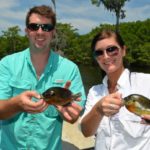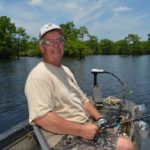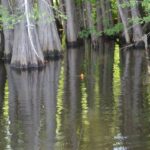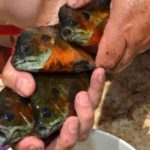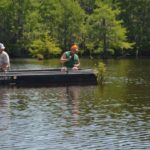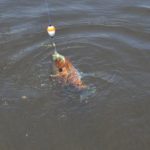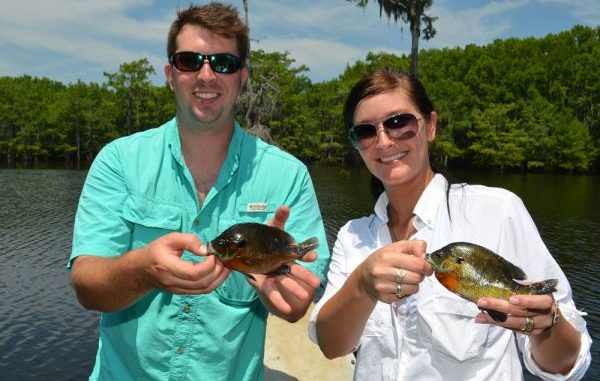
Bream might not be on huge beds like they were in the spring, but August is the last chance to catch them spawning. Here’s how to do.
OK, it’s August.
It’s hot — really, really hot. Bass have lockjaw. Crappie have disappeared. Catfish have retreated into the deepest holes in the river.
So you turn to bream, those fish you massacred on their first bedding in May. You know: those fish that “anyone can catch.”
Trouble is, not just anyone can catch big bream during this last month of their spawning season. Those big beds of spawning bulls aggressively protecting their nests are not there anymore.
So how do you find them?
Tommy Nugent of Pineville knows you have to go stump jumping.
At least that’s what he told Martin Close and his son and daughter, Grayson and Liz, one night over grilled steaks at the Close family camp on Little River in LaSalle Parish.
Nugent owns a camp on nearby Kitterlin Bay (pronounced “Kitlin”). For the uninitiated, a bay is a lake in Central Louisiana vernacular. About 80 percent of the 865-acre lake is controlled by Kitterlin Creek Outfitters, which has a fishing club to which Nugent belongs.
Like so many small Central and North Louisiana reservoirs, Kitterlin Bay is heavily studded with cypress trees and old stumps.
The veteran fisherman paid close attention to his steak, but worked into the conversation that he really chases largemouth bass hard nowadays, followed by crappie — but that he used to fish bream hard.
“I had to clean too many of them,” he said. “When you catch 200 fish, that\’s a lot of cleaning.”
“That\’s a problem a lot of people would like to have,” said one of the others in the camp.
Nugent\’s only reply was a huge, crooked grin.
After he put his knife and fork down, he rubbed his tummy and peered at the elder Close through his glasses.
“I\’ll take you fishing in the stumps tomorrow, if you want,” Nugent said.
He didn\’t have to offer twice.
A beaming sun the next morning found the quartet cruising a lake as much green with trees as blue with water. Nugent was chauffeuring Martin in a vintage banana boat hull, powered only by a trolling motor. Grayson and Liz, in their own boat, hung fairly close to Nugent at first to learn the ropes about stump jumping.
It became obvious very early that when Nugent told the trio that they would be fishing in stumps, they misunderstood his meaning. Like most experienced bream fishermen, they were irresistibly drawn to throwing a bait near every tree trunk and stump. Those casts produced nary a wiggle in the cork.
It was hard for the veteran bream-slayers to believe, but Nugent soon set them straight.
“You gotta throw in the stump,” directed Nugent, with an emphasis on the word “in.” In his vocabulary, “in” meant inside the hollow spot of a stump rather than among stumps.
Martin, being in the same boat with Nugent, was the first to catch on. After all, Nugent trolled him right up to a stump and pointed out where to drop his cricket.
The ideal target was a completely hollow stump, with raggedy edges of the circular rim protruding above water. Often, small woody saplings were growing where they had taken a precarious hold on a piece of stump edge.
Some stumps were obvious, with a distinct circle made up of pieces of rim wood around a hollow center. Others were harder to find. In many cases, only a single, tiny piece of wood protruded from the water. Every piece had to be investigated. A closer approach then revealed the rest of the submerged circle of wood.
Some were completely underwater with nothing showing, a problem Grayson partially solved by standing while he worked the trolling motor to allow him to more closely inspect the water to either side and in front of the boat as he moved it.
Martin put a half-dozen big bream in the boat under Nugent’s guidance before the two younger Closes caught on. While Grayson was still casting in the usual bream places, near stumps and tree trunks, sister Liz started bulls-eyeing the center of stumps.
She quickly put four of the little monsters in the boat, much to Grayson’s disgust.
She rubbed it in, and he fought back — heaping his share of abuse on her when he started catching fish. She spied me sitting aside taking it all in and flashed a megawatt smile.
“This isn’t bad,” she said. “We’re not talking as much smack as we usually do since you are with us.”
She flounced her dark pony tail and went back to fishing. After all, her brother might get ahead of her.
For his part, Grayson was having a field day, using his polarized sunglasses to look down into the stump hollows, calling out how many bull bluegill he saw and their sizes.
“It\’s like looking in an aquarium,” he sang in amazement.
One bright-colored fish after another came out of the water, first running in every-tightening circles, and then flouncing and splashing violently as they were unceremoniously levered up.
A few stumps yielded no fish, but most gave up one. A few produced two bream, and an especially good one would produce three or four fish, but never more.
The strategy was to hit a stump, and as soon as it didn’t produce another bite as soon as the bait hit the water, to jump to the next stump.
Liz and Grayson ran out of crickets first and had to watch enviously while their father fished the last few out of his cage.
“I love this,” he muttered for their benefit, as he chased the last cricket in the cage. “If I had more bait, I could stay out here all day.”
